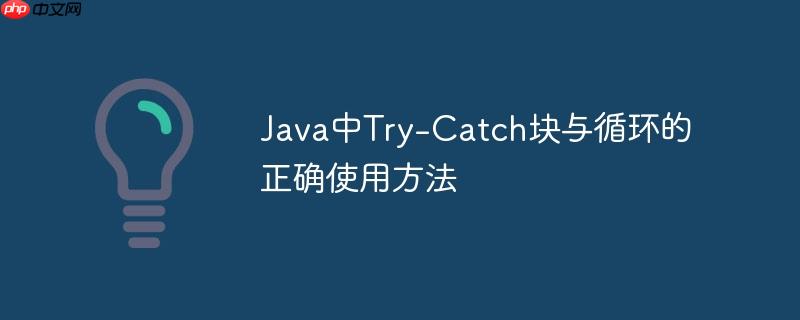
本文旨在阐明在Java编程中,当try-catch块与for循环结合使用时,异常处理如何影响循环的执行流程。通过分析一个汽车租赁服务的示例,详细解释了将try-catch块放置在循环外部和内部的区别,并提供了正确的代码结构以确保程序在遇到异常时能够继续执行。
在Java编程中,合理地使用try-catch块进行异常处理至关重要,尤其是在循环结构中。try-catch块的位置会直接影响程序的执行流程和结果。本文将通过一个实际的汽车租赁服务示例,深入探讨try-catch块在for循环中的作用,并提供正确的代码结构以应对各种异常情况。
Try-Catch块与For循环的位置关系
当for循环位于try块内部时,如果在循环的某一次迭代中抛出异常,程序会立即跳转到catch块中执行。执行完catch块后,循环将终止,不会继续执行剩余的迭代。
try { for (int i = 0; i < 5; i++) { // 可能抛出异常的代码 System.out.println("Iteration: " + i); if (i == 2) { throw new Exception("Exception at iteration 2"); } } } catch (Exception e) { System.out.println("Caught exception: " + e.getMessage()); } System.out.println("After the try-catch block");
上述代码的输出结果为:
立即学习“Java免费学习笔记(深入)”;
Iteration: 0 Iteration: 1 Iteration: 2 Caught exception: Exception at iteration 2 After the try-catch block
可以看到,当i等于2时抛出异常,程序跳转到catch块,并打印异常信息。然后,程序继续执行try-catch块之后的代码,但for循环已经终止。
将Try-Catch块置于For循环内部
为了使循环在遇到异常时能够继续执行,我们需要将try-catch块放置在for循环内部。这样,每次迭代都会被try-catch块包裹,当某次迭代抛出异常时,只会影响该次迭代,而不会中断整个循环。
for (int i = 0; i < 5; i++) { try { // 可能抛出异常的代码 System.out.println("Iteration: " + i); if (i == 2) { throw new Exception("Exception at iteration 2"); } } catch (Exception e) { System.out.println("Caught exception: " + e.getMessage() + " at iteration " + i); } } System.out.println("After the loop");
上述代码的输出结果为:
立即学习“Java免费学习笔记(深入)”;
Iteration: 0 Iteration: 1 Iteration: 2 Caught exception: Exception at iteration 2 at iteration 2 Iteration: 3 Iteration: 4 After the loop
可以看到,当i等于2时抛出异常,程序跳转到catch块,并打印异常信息。然后,程序继续执行下一次迭代,直到循环结束。
汽车租赁服务示例分析
现在,让我们回到汽车租赁服务的示例,分析如何正确地使用try-catch块。
原始代码的问题在于,try-catch块位于for循环外部,导致在处理第一个租车请求时如果发生异常,整个循环都会被中断,无法处理后续的请求。
int num = s.nextInt(); //input the number of car rental requests try { for(int i=1;i<=num;i++) { int heads = s.nextInt(); //enter head count of passengers s.nextLine(); //enter destination String dest = s.nextLine(); CarRental obj = new CarRental(heads,dest); obj.carBooker(); } }catch(Exception e) { System.out.println(e.getMessage()); }
为了解决这个问题,我们需要将try-catch块放置在for循环内部:
int num = s.nextInt(); //input the number of car rental requests for(int i=1;i<=num;i++) { try { int heads = s.nextInt(); //enter head count of passengers s.nextLine(); //enter destination String dest = s.nextLine(); CarRental obj = new CarRental(heads,dest); obj.carBooker(); }catch(Exception e) { System.out.println(e.getMessage()); } }
通过将try-catch块放置在for循环内部,即使在处理某个租车请求时发生异常,程序仍然可以继续处理后续的请求,从而得到期望的输出结果。
CarRental类的改进
此外,CarRental类的carBooker()方法也需要进行一些改进,以确保异常处理的正确性。
原始代码中,carBooker()方法抛出ArithmeticException和NullPointerException,并在catch块中将其转换为自定义的异常类型ImproperHeadCountException和WrongDestinationException。
public void carBooker() throws ArithmeticException, NullPointerException{ //define this method according to the problem description try{ if (this.passenger_count < 1){ throw new ArithmeticException(); } double fare_per_head = available_destinations.get(this.chosen_destination)/this.passenger_count; System.out.println("Destination: " + this.chosen_destination + ", " + "Head cost:" + fare_per_head); }catch(NullPointerException e){ WrongDestinationException newe = new WrongDestinationException(); e.initCause(newe); throw e; }catch(ArithmeticException e_){ ImproperHeadCountException newe_ = new ImproperHeadCountException(); e_.initCause(newe_); throw e_; } }
更好的做法是直接抛出自定义的异常类型,并在方法签名中声明这些异常:
public void carBooker() throws ImproperHeadCountException, WrongDestinationException { try { if (this.passenger_count < 1) { throw new ImproperHeadCountException("Head count should be positive non zero value"); } if (!available_destinations.containsKey(this.chosen_destination)) { throw new WrongDestinationException("Invalid destination"); } double fare_per_head = available_destinations.get(this.chosen_destination) / this.passenger_count; System.out.println("Destination: " + this.chosen_destination + ", Head cost: " + fare_per_head); } catch (NullPointerException e) { throw new WrongDestinationException("Invalid destination"); } }
总结
通过本文的分析,我们了解到try-catch块在for循环中的位置对程序的执行流程至关重要。将try-catch块放置在循环内部可以确保程序在遇到异常时能够继续执行,从而处理更多的请求或数据。同时,我们也学习了如何更好地设计异常处理逻辑,使代码更加清晰和易于维护。在实际编程中,应根据具体需求选择合适的try-catch块位置,并合理地处理各种异常情况,以提高程序的健壮性和可靠性。



















